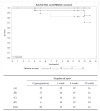Safety and Efficacy of the Rho-Kinase Inhibitor (Ripasudil) in Bleb Needling after Trabeculectomy: A Prospective Multicenter Study
- PMID: 38202082
- PMCID: PMC10780264
- DOI: 10.3390/jcm13010075
Safety and Efficacy of the Rho-Kinase Inhibitor (Ripasudil) in Bleb Needling after Trabeculectomy: A Prospective Multicenter Study
Abstract
Ripasudil, a rho-associated protein kinase inhibitor ophthalmic solution, shows a protective effect in preventing excessive scarring in vitro. This study aims to evaluate the safety and efficacy of ripasudil for glaucoma patients submitted to the needling procedure. In this prospective, multicenter, single-arm study, we included 20 eyes of 20 patients with glaucoma who underwent the needling procedure without antimetabolites. All patients administered ripasudil after needling for three months. The primary endpoint of this study was the safety of ripasudil in patients, and the secondary endpoint was the change in IOP at 12 weeks after the needling procedure. No serious complications were found in the patients. One eye experienced pruritus and conjunctival follicle, while another eye had conjunctival follicle. These complications were transient and resolved quickly after discontinuation of ripasudil. The mean preoperative IOP was 14.6 ± 4.6 mmHg, which decreased to 11.0 ± 4.7 mmHg (p = 0.0062) at 1 week postoperatively. The IOP reduction effect continued to 12 weeks (11.8 ± 3.1 mmHg; p = 0.0448). The administration of the ROCK inhibitor, ripasudil, after the needling procedure is safe and effective in maintaining IOP for 12 weeks.
Keywords: a rho-associated protein kinase inhibitor; glaucoma; needling; ripasudil; trabeculectomy.
Conflict of interest statement
The authors declare no conflict of interest.
Figures



Similar articles
-
A multicenter phase II study on the safety of rho-kinase inhibitor (ripasudil) with needling for the patients after trabeculectomy.Contemp Clin Trials Commun. 2023 Jun 4;33:101160. doi: 10.1016/j.conctc.2023.101160. eCollection 2023 Jun. Contemp Clin Trials Commun. 2023. PMID: 37333977 Free PMC article.
-
Effect of the rho-kinase inhibitor ripasudil in needling with mitomycin C for the failure of filtering bleb after trabeculectomy: a cross-sectional study.BMC Ophthalmol. 2022 Nov 14;22(1):433. doi: 10.1186/s12886-022-02680-9. BMC Ophthalmol. 2022. PMID: 36376831 Free PMC article.
-
The Additive Effect of ROCK Inhibitor on Prostaglandin-Treated Japanese Patients with Glaucoma Indicating 15 mmHg and Under: ROCK U-15.Adv Ther. 2021 Jul;38(7):3760-3770. doi: 10.1007/s12325-021-01775-x. Epub 2021 May 24. Adv Ther. 2021. PMID: 34028695 Free PMC article.
-
Ripasudil Hydrochloride Hydrate in the Treatment of Glaucoma: Safety, Efficacy, and Patient Selection.Clin Ophthalmol. 2020 May 6;14:1229-1236. doi: 10.2147/OPTH.S216907. eCollection 2020. Clin Ophthalmol. 2020. PMID: 32440089 Free PMC article. Review.
-
Intraocular pressure-lowering efficacy and ocular safety of Rho-kinase inhibitor in glaucoma: a meta-analysis and systematic review of prospective randomized trials.Graefes Arch Clin Exp Ophthalmol. 2022 Mar;260(3):937-948. doi: 10.1007/s00417-021-05379-7. Epub 2021 Sep 7. Graefes Arch Clin Exp Ophthalmol. 2022. PMID: 34491427
Cited by
-
The Application of Rho Kinase Inhibitors in the Management of Glaucoma.Int J Mol Sci. 2024 May 21;25(11):5576. doi: 10.3390/ijms25115576. Int J Mol Sci. 2024. PMID: 38891764 Free PMC article. Review.
-
Rho Kinase Inhibitors in Glaucoma Management: Current Perspectives and Future Directions.Drug Des Devel Ther. 2025 Apr 2;19:2519-2531. doi: 10.2147/DDDT.S515166. eCollection 2025. Drug Des Devel Ther. 2025. PMID: 40190809 Free PMC article. Review.
References
Grants and funding
LinkOut - more resources
Full Text Sources

